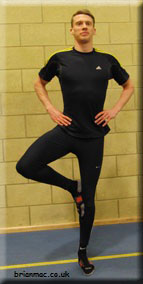

Standing Stork Test - Blind
Testing and measurement are the means of collecting information upon which subsequent performance evaluations and decisions are made. In the analysis, we need to consider the factors influencing the results.
Objective
To monitor the development of the athlete's ability to maintain a state of equilibrium (balance) in a static position.
Required Resources
To conduct this test, you will require:
- Warm, dry location - gym
- Stopwatch
- An assistant
How to conduct the test
|
 |
Analysis
Analysis of the test result is by comparing it with the athlete's previous results for this test. It is expected that the analysis would indicate an improvement in the athlete's static balance with appropriate training between each test.
Target Group
This test is suitable for active individuals but not for those where the test would be contraindicated.
Reliability
Test reliability refers to the degree to which a test is consistent and stable in measuring what it is intended to measure. Reliability will depend upon how strict the test is conducted and the individual's level of motivation to perform the test. The following link provides a variety of factors influencing the results and the test reliability.
Validity
Test validity refers to the degree to which the test measures what it claims to measure and the extent to which inferences, conclusions, and decisions based on test scores are appropriate and meaningful. This test provides a means to monitor the effect of training on the athlete's physical development.
Advantages
- No equipment required
- Simple to set up and conduct
- Can be conducted almost anywhere
Disadvantages
- Assistant required to administer the test
References
- ARNOT, R. and GAINES, C. (1984) Sports Talent. Harmondsworth: Penguin
Page Reference
If you quote information from this page in your work, then the reference for this page is:
- MACKENZIE, B. (2004) Standing Stork Test - Blind [WWW] Available from: https://www.brianmac.co.uk/bstorktst.htm [Accessed